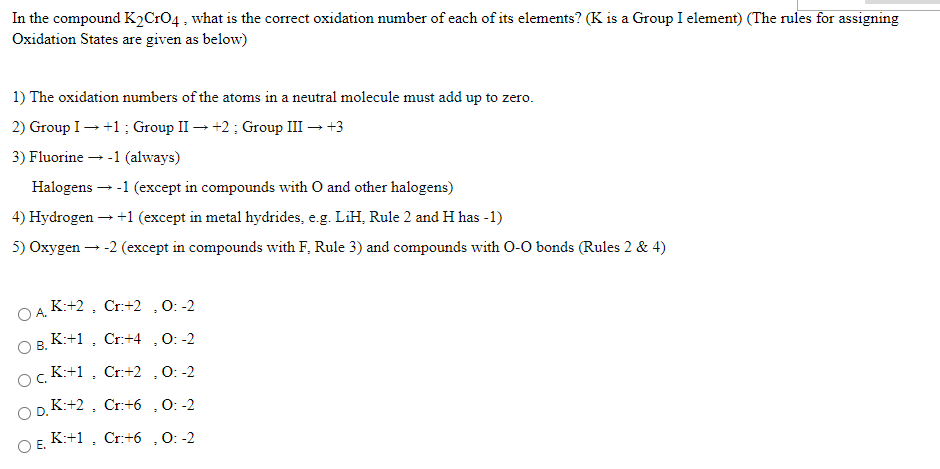In the compound K2C1O4 , what is the correct oxidation number of each of its elements? (K is a Group I element) (The rules for assigning Oxidation States are given as below) 1) The oxidation numbers of the atoms in a neutral molecule must add up to zero. 2) Group I → +1 ; Group II → +2 ; Group I → +3 3) Fluorine → -1 (always) Halogens - -1 (except in compounds with O and other halogens) 4) Hydrogen → +1 (except in metal hydrides, e.g. LiH, Rule 2 and H has -1) 5) Oxygen -2 (except in compounds with F, Rule 3) and compounds with 0-0 bonds (Rules 2 & 4) OA K:+2 , Cr:+2 ,O: -2 O B. K:+1 , Cr:+4 ,O: -2 ocK:+1 , Cr:+2 ,O: -2 O D.K:+2, Cr:+6 ,O: -2 K:+1 , Cr:+6 ,O: -2 O E.
In the compound K2C1O4 , what is the correct oxidation number of each of its elements? (K is a Group I element) (The rules for assigning Oxidation States are given as below) 1) The oxidation numbers of the atoms in a neutral molecule must add up to zero. 2) Group I → +1 ; Group II → +2 ; Group I → +3 3) Fluorine → -1 (always) Halogens - -1 (except in compounds with O and other halogens) 4) Hydrogen → +1 (except in metal hydrides, e.g. LiH, Rule 2 and H has -1) 5) Oxygen -2 (except in compounds with F, Rule 3) and compounds with 0-0 bonds (Rules 2 & 4) OA K:+2 , Cr:+2 ,O: -2 O B. K:+1 , Cr:+4 ,O: -2 ocK:+1 , Cr:+2 ,O: -2 O D.K:+2, Cr:+6 ,O: -2 K:+1 , Cr:+6 ,O: -2 O E.
Chemistry
10th Edition
ISBN:9781305957404
Author:Steven S. Zumdahl, Susan A. Zumdahl, Donald J. DeCoste
Publisher:Steven S. Zumdahl, Susan A. Zumdahl, Donald J. DeCoste
Chapter18: Electrochemistry
Section: Chapter Questions
Problem 1ALQ
Related questions
Question

Transcribed Image Text:In the compound K2CrO4 , what is the correct oxidation number of each of its elements? (K is a Group I element) (The rules for assigning
Oxidation States are given as below)
1) The oxidation numbers of the atoms in a neutral molecule must add up to zero.
2) Group I- +1; Group II – +2; Group III → +3
3) Fluorine - -1 (always)
Halogens – -1 (except in compounds with O and other halogens)
4) Hydrogen-
+1 (except in metal hydrides, e.g. LiH, Rule 2 and H has -1)
5) Oxygen – -2 (except in compounds with F, Rule 3) and compounds with O-0 bonds (Rules 2 & 4)
OA K:+2 , Cr:+2 ,0: -2
OB. K:+1 , Cr:+4 ,0: -2
ocK:+1 , Cr:+2 ,O: -2
OD.K:+2 , Cr:+6 ,0: -2
O E. K:+1 , Cr:+6 ,0: -2
Expert Solution
This question has been solved!
Explore an expertly crafted, step-by-step solution for a thorough understanding of key concepts.
This is a popular solution!
Trending now
This is a popular solution!
Step by step
Solved in 4 steps with 1 images

Knowledge Booster
Learn more about
Need a deep-dive on the concept behind this application? Look no further. Learn more about this topic, chemistry and related others by exploring similar questions and additional content below.Recommended textbooks for you

Chemistry
Chemistry
ISBN:
9781305957404
Author:
Steven S. Zumdahl, Susan A. Zumdahl, Donald J. DeCoste
Publisher:
Cengage Learning

General Chemistry - Standalone book (MindTap Cour…
Chemistry
ISBN:
9781305580343
Author:
Steven D. Gammon, Ebbing, Darrell Ebbing, Steven D., Darrell; Gammon, Darrell Ebbing; Steven D. Gammon, Darrell D.; Gammon, Ebbing; Steven D. Gammon; Darrell
Publisher:
Cengage Learning

Chemistry: The Molecular Science
Chemistry
ISBN:
9781285199047
Author:
John W. Moore, Conrad L. Stanitski
Publisher:
Cengage Learning

Chemistry
Chemistry
ISBN:
9781305957404
Author:
Steven S. Zumdahl, Susan A. Zumdahl, Donald J. DeCoste
Publisher:
Cengage Learning

General Chemistry - Standalone book (MindTap Cour…
Chemistry
ISBN:
9781305580343
Author:
Steven D. Gammon, Ebbing, Darrell Ebbing, Steven D., Darrell; Gammon, Darrell Ebbing; Steven D. Gammon, Darrell D.; Gammon, Ebbing; Steven D. Gammon; Darrell
Publisher:
Cengage Learning

Chemistry: The Molecular Science
Chemistry
ISBN:
9781285199047
Author:
John W. Moore, Conrad L. Stanitski
Publisher:
Cengage Learning

Chemistry: Principles and Reactions
Chemistry
ISBN:
9781305079373
Author:
William L. Masterton, Cecile N. Hurley
Publisher:
Cengage Learning

Chemistry & Chemical Reactivity
Chemistry
ISBN:
9781337399074
Author:
John C. Kotz, Paul M. Treichel, John Townsend, David Treichel
Publisher:
Cengage Learning

Chemistry & Chemical Reactivity
Chemistry
ISBN:
9781133949640
Author:
John C. Kotz, Paul M. Treichel, John Townsend, David Treichel
Publisher:
Cengage Learning